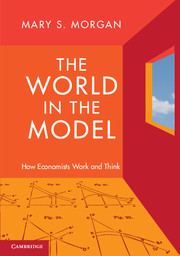Book contents
- Frontmatter
- Contents
- Figures, Tables, and Boxes
- Preface
- 1 Modelling as a Method of Enquiry
- 2 Model-Making: New Recipes, Ingredients, and Integration
- 3 Imagining and Imaging: Creating a New Model World
- 4 Character Making: Ideal Types, Idealization, and the Art of Caricature
- 5 Metaphors and Analogies: Choosing the World of the Model
- 6 Questions and Stories: Capturing the Heart of Matters
- 7 Model Experiments?
- 8 Simulation: Bringing a Microscope into Economics
- 9 Model Situations, Typical Cases, and Exemplary Narratives
- 10 From the World in the Model to the Model in the World
- Index
- Plate Section
- References
8 - Simulation: Bringing a Microscope into Economics
Published online by Cambridge University Press: 05 November 2012
- Frontmatter
- Contents
- Figures, Tables, and Boxes
- Preface
- 1 Modelling as a Method of Enquiry
- 2 Model-Making: New Recipes, Ingredients, and Integration
- 3 Imagining and Imaging: Creating a New Model World
- 4 Character Making: Ideal Types, Idealization, and the Art of Caricature
- 5 Metaphors and Analogies: Choosing the World of the Model
- 6 Questions and Stories: Capturing the Heart of Matters
- 7 Model Experiments?
- 8 Simulation: Bringing a Microscope into Economics
- 9 Model Situations, Typical Cases, and Exemplary Narratives
- 10 From the World in the Model to the Model in the World
- Index
- Plate Section
- References
Summary
The Birth of a New Technology
It is evident that one of primary places of use for models in modern sciences lies in various kinds of simulation. Economics is no exception: a distinctive culture of simulation emerged in the social sciences in the years around 1960. This sudden explosion in the use of the term “simulation” covered a very broad range of practises: a variety of types of ‘experiments’ including people in role-playing experiments (known then as “gaming”), computation machines, probability setups, statistical data, mathematical models, and games of chance. All these elements fitted under the same umbrella, and so apart from the notion of mimicking, or imitation, inherent in the meaning of the term ‘simulation’, the possibilities of giving a neat definition are small. The extraordinary range of the term is revealed in a bibliography in the house journal of the American Statistical Association, and in a symposium in the house journal of the American Economic Association, both in 1960. These documents allow us to explore the connotations of the new term ‘simulation’ in economics and to trace back its separate roots into the interwar period. Each of the elements has its own longer tradition, yet, like a family tree where the same first names keep reappearing through the generations, the elements of simulation in economics often tangle together and reappear.
My particular interests in this literature are twofold. The first is to understand the historical dynamic by which the newly emerged method of modelling came to be combined with an older experimental tradition from statistics, a newer experimental mode in social sciences, and the new research tool of the computer, to form the technology of simulation. This is, not by intent but by content, a largely American history, situated within the immediate context of the Cold War and its research technologies. My historical enquiry focusses on two figures, Martin Shubik and Guy Orcutt, who played an important developmental role in creating simulation techniques in economics. Their personal histories help us to understand how the new technology was broadly constituted out of some old and some new techniques and ideas, and yet encompassed a considerable variety of simulation types.
Information
- Type
- Chapter
- Information
- The World in the ModelHow Economists Work and Think, pp. 301 - 343Publisher: Cambridge University PressPrint publication year: 2012
